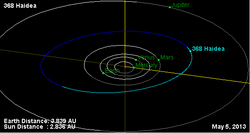Astronomy:368 Haidea
From HandWiki
Short description: Main-belt asteroid
 Orbital diagram | |
| Discovery | |
|---|---|
| Discovered by | Auguste Charlois |
| Discovery date | 19 May 1893 |
| Designations | |
| (368) Haidea | |
| 1893 AB | |
| Minor planet category | Main belt |
| Orbital characteristics[1] | |
| Epoch 31 July 2016 (JD 2457600.5) | |
| Uncertainty parameter 0 | |
| Observation arc | 110.46 yr (40344 d) |
| |{{{apsis}}}|helion}} | 3.6914 astronomical unit|AU (552.23 Gm) |
| |{{{apsis}}}|helion}} | 2.4594 AU (367.92 Gm) |
| 3.0754 AU (460.07 Gm) | |
| Eccentricity | 0.20031 |
| Orbital period | 5.39 yr (1969.9 d) |
| Mean anomaly | 270.180° |
| Mean motion | 0° 10m 57.9s / day |
| Inclination | 7.7935° |
| Longitude of ascending node | 226.340° |
| 94.934° | |
| Physical characteristics | |
| Dimensions | 69.61±2.2 km |
| Rotation period | 9.823 h (0.4093 d) |
| Geometric albedo | 0.0389±0.003 |
| PD | |
| Absolute magnitude (H) | 9.93 |
Haidea (minor planet designation: 368 Haidea) is a large asteroid residing in the asteroid belt.[1] It was discovered by Auguste Charlois on 19 May 1893 in Nice.
Its name meaning is not known; it may be taken from the opera Haydée or one of several fictional characters named Haidée. The Tagish Lake meteorite is believed to derive from 368 Haidea, due to its reflectance spectrum.[2]
References
- ↑ 1.0 1.1 "368 Haidea (1893 AB)". JPL Small-Body Database. NASA/Jet Propulsion Laboratory. https://ssd.jpl.nasa.gov/sbdb.cgi?sstr=368;cad=1.
- ↑ Asteroids: Overview, Abstracts, and Bibliography. (2002:78). United States: Nova Science Publishers.
External links
- 368 Haidea at AstDyS-2, Asteroids—Dynamic Site
- 368 Haidea at the JPL Small-Body Database
 |

